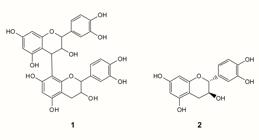Due to the increase of bacterial resistance, the search for new antibiotics is necessary and the medicinal plants represent its most important source. The aim of this study was to evaluate the antibacterial property of extract and fractions from Protium spruceanum leaves, against pathogenic bacteria. By means of diffusion and microdilution assays, the crude extract was active against the nine bacteria tested being the hydromethanolic fraction the most active. During phytochemical procedures, procyanidin (1) and catechin (2) were identified as the main antibacterial constituents of this fraction. In silico results obtained using PASSonline tool indicated 1 and 2 as having good potential to interact with different targets of currently used antibiotics. These results no indicated potential to none DNA effect and indicated the cell wall as mainly target. Electrophoresis result supported that had no DNA damage. Cell wall damage was confirmed by propidium iodide test that showed increased membrane permeability and by cell surface deformations observed in scanning electronic microscopy. The in vitro assays together with the in silico prediction results establish the potential of P. spruceanum as source of antibacterial compounds that acts on important bacterial targets. These results contribute to the development of natural substances against pathogenic bacteria and to discovery of new antibiotics.
Keywords:
Protium spruceanum; Burseraceae; Procyanidin; Catechin; Antibacterial activity

 Thumbnail
Thumbnail
 Thumbnail
Thumbnail

